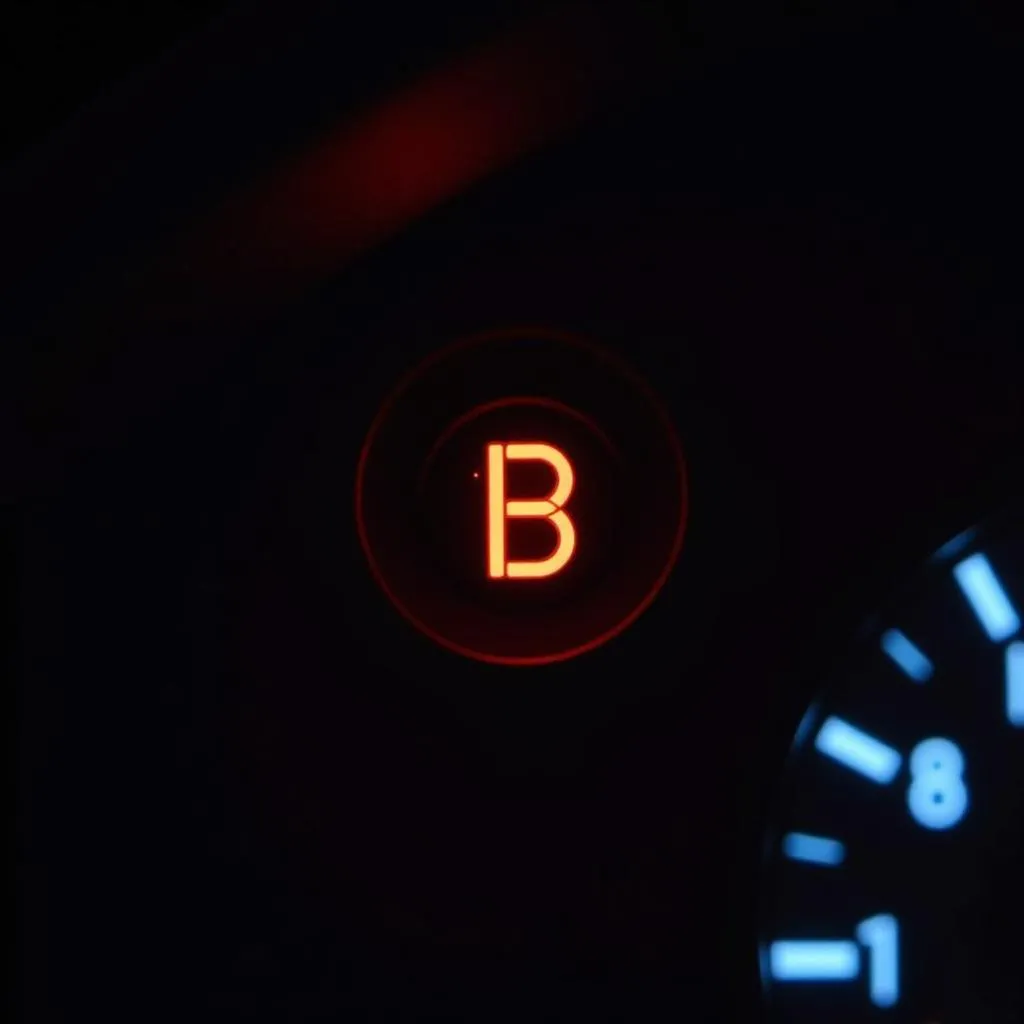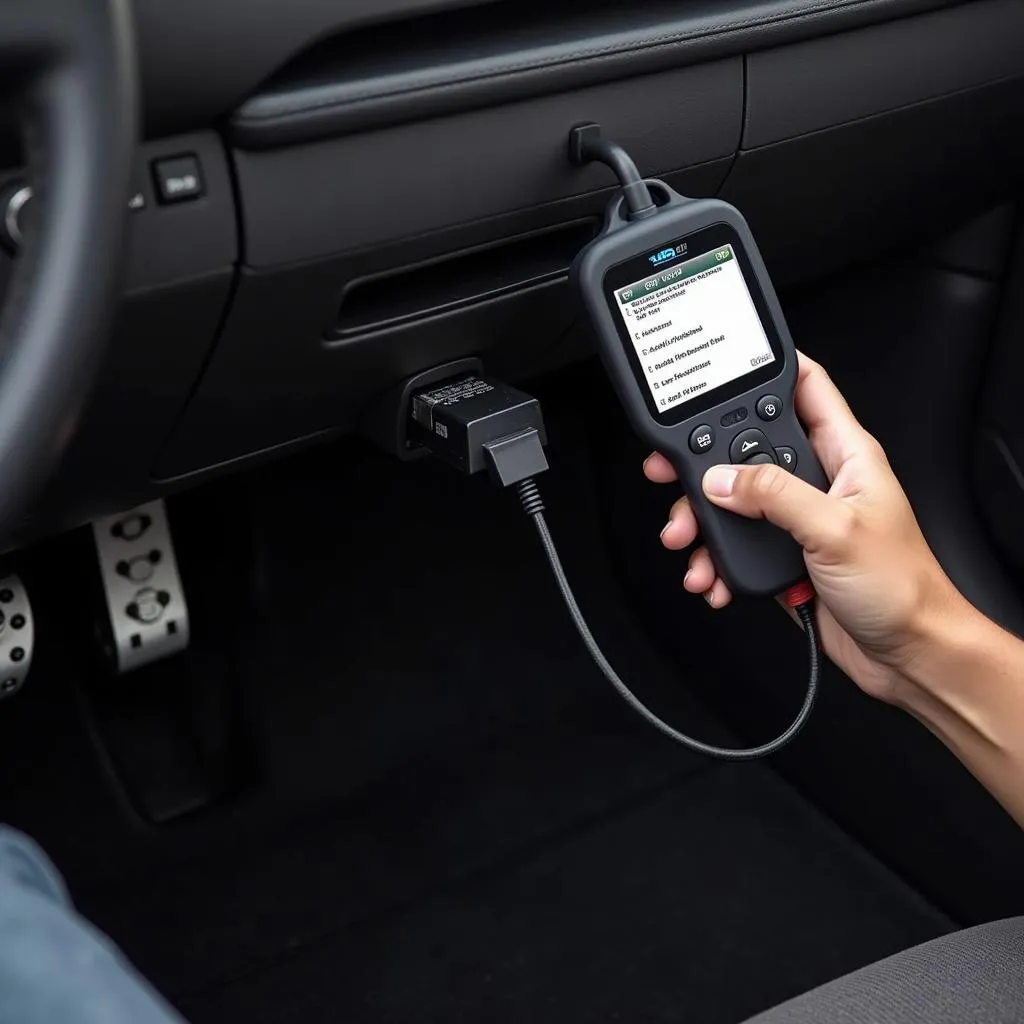Car codes, those cryptic messages your vehicle displays on the dashboard, can be a source of anxiety for any car owner. Whether it’s a flashing check engine light or an unfamiliar symbol, these codes are your car’s way of communicating a problem. This guide will demystify car codes, explaining what they are, how to read them, and what to do when they appear.
What Exactly is a Car Code?
A car code, also known as a Diagnostic Trouble Code (DTC), is a five-character alphanumeric code that represents a specific malfunction detected by your car’s onboard computer, the Engine Control Unit (ECU). When a sensor in your car detects an issue within a system, it sends a signal to the ECU, which then generates the corresponding code.
These codes are standardized by the Society of Automotive Engineers (SAE), ensuring consistency across different car manufacturers. This means a “P0301” code signifies the same problem whether you drive a Toyota or a Ford.
 Car Dashboard with Illuminated Check Engine Light
Car Dashboard with Illuminated Check Engine Light
Deciphering the Code: What do the letters and numbers mean?
Each character in a car code carries specific information about the problem:
-
First Character: Indicates the system where the fault originates.
- P: Powertrain (engine, transmission, emissions)
- B: Body (airbags, power seats, central locking)
- C: Chassis (ABS, traction control, suspension)
- U: Network & Communication (modules, wiring)
-
Second Character: Specifies whether the code is generic (common to all vehicles) or manufacturer-specific.
- 0: Generic (SAE-defined)
- 1-2: Manufacturer-specific
-
Third Character: Pinpoints the specific subsystem related to the fault.
- 1: Fuel and Air Metering
- 2: Fuel and Air Metering (Injector Circuit)
- 3: Ignition System or Misfire
- 4: Auxiliary Emissions Controls
- 5: Vehicle Speed Control and Idle Control System
- 6: Computer Output Circuit
- 7 & 8: Transmission
-
Fourth and Fifth Characters: These two digits represent the individual fault within the subsystem. For instance, “01” could indicate a general sensor malfunction, while “04” might point to a specific issue within that sensor’s circuit.
 OBD2 Scanner Connected to a Car's Diagnostic Port
OBD2 Scanner Connected to a Car's Diagnostic Port
How to Read Car Codes
While understanding the code structure is helpful, it doesn’t provide the complete picture. To get a clear diagnosis, you’ll need a device called an OBD2 scanner.
OBD2 scanners are readily available for purchase online and at auto parts stores. These handy tools connect to your car’s OBD2 port (usually located under the dashboard) and retrieve the stored car codes. Many scanners also offer definitions for common codes, giving you a basic understanding of the problem.
Once you have the code, you can:
- Consult your OBD2 scanner’s manual: Many scanners include a built-in code library.
- Search online: Websites like DiagXcar offer comprehensive car code databases and helpful resources.
- Talk to a mechanic: A qualified mechanic can accurately diagnose and repair the issue.
Common Car Codes and Their Meanings
While thousands of potential car codes exist, some appear more frequently than others. Here are a few examples:
-
P0420: Catalyst System Efficiency Below Threshold (Bank 1) – This code usually indicates a problem with the catalytic converter, a crucial component of your car’s emissions system.
-
P0301: Cylinder 1 Misfire Detected – This code points to an issue with the engine’s combustion process in cylinder 1. Causes can range from faulty spark plugs to fuel injector problems.
-
P0171: System Too Lean (Bank 1) – This code signifies that the engine is running lean, meaning there’s too much air compared to fuel in the air-fuel mixture.
-
P0101: Mass Air Flow (MAF) Sensor Performance Problem – The MAF sensor measures the amount of air entering the engine. This code indicates a problem with the sensor or its circuit.
 Mechanic Examining a Car Engine
Mechanic Examining a Car Engine
When to Seek Professional Help
While some car codes might point to minor issues you can potentially address yourself, others require professional attention. Here’s when to call a mechanic:
- Recurring Codes: If a code reappears after being cleared, it indicates a persistent problem that needs further investigation.
- Multiple Codes: The presence of numerous codes can complicate diagnosis and often points to a more serious underlying issue.
- Safety Concerns: Codes related to brakes, airbags, or other critical safety systems require immediate attention from a qualified technician.
OBD2 Scanner: Your Key to Understanding Car Codes
Investing in a reliable OBD2 scanner is crucial for any car owner. These devices empower you to take control of your car’s maintenance, understand potential issues, and make informed decisions about repairs.
DiagXcar offers a wide range of high-quality OBD2 scanners, from basic code readers to advanced diagnostic tools. Visit our website to find the perfect scanner for your needs and gain a deeper understanding of your vehicle’s health.
Car Code FAQs:
1. Can I drive my car with the check engine light on?
While you might be able to drive short distances with the check engine light on, it’s crucial to get the code diagnosed as soon as possible. Ignoring the warning could lead to further damage and more costly repairs.
2. Will disconnecting the battery reset the check engine light?
Temporarily disconnecting the battery can sometimes clear car codes and reset the check engine light. However, this is not a permanent fix. If the underlying problem persists, the light will return.
3. Are all car codes serious?
Not all car codes indicate major problems. Some might signal minor issues like a loose gas cap or a faulty sensor. However, it’s always best to err on the side of caution and have any illuminated warning lights checked by a professional.
4. Can car codes be prevented?
While you can’t eliminate the possibility of car codes altogether, regular vehicle maintenance, including oil changes, tune-ups, and inspections, can significantly reduce their occurrence.
5. Can I fix a car code myself?
While some DIY enthusiasts might feel comfortable tackling minor repairs based on car code diagnoses, it’s essential to proceed with caution. Incorrectly diagnosing or repairing a problem could lead to more significant damage.
6. How often should I check for car codes?
It’s generally a good practice to check for car codes periodically, even if your check engine light isn’t on. This proactive approach can help identify potential problems early on, preventing more severe issues and costly repairs.
7. What is the difference between an OBD2 scanner and a code reader?
While both devices can retrieve car codes, OBD2 scanners typically offer more advanced features like live data streaming, sensor readings, and emissions readiness tests.
Need More Help with Car Codes?
Understanding car codes can be daunting, but it doesn’t have to be a mystery. DiagXcar is here to guide you through the process. We offer a wealth of resources, including detailed car code definitions, helpful articles, and reviews of the latest diagnostic tools.
For further assistance or to explore our selection of OBD2 scanners, visit our website or contact our team of experts. We’re always here to help you keep your car running smoothly.
Get in touch with our team of experts!
WhatsApp: +1(641)206-8880
Email: [email protected]
Address: 276 Reock St, City of Orange, NJ 07050, United States
We offer 24/7 customer support!